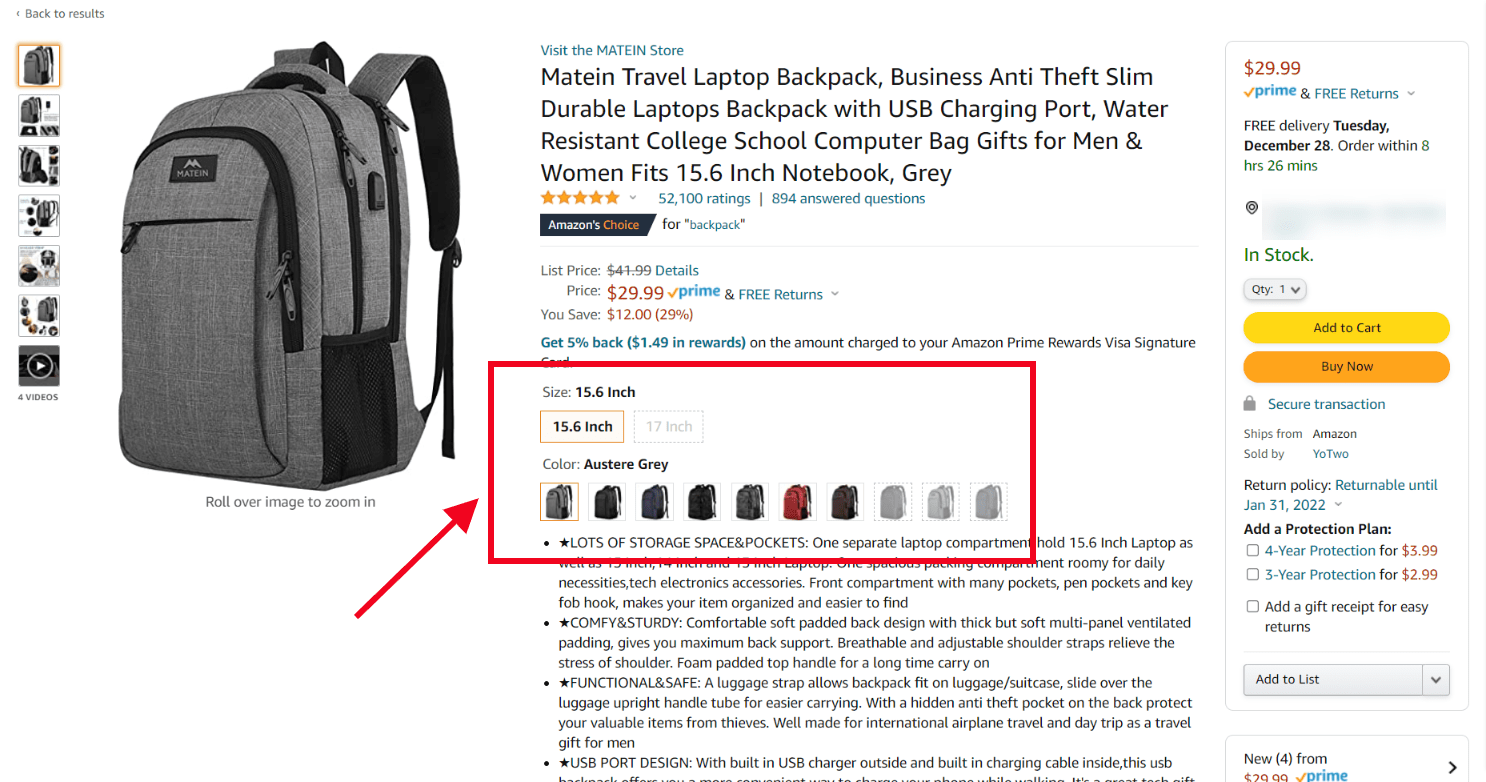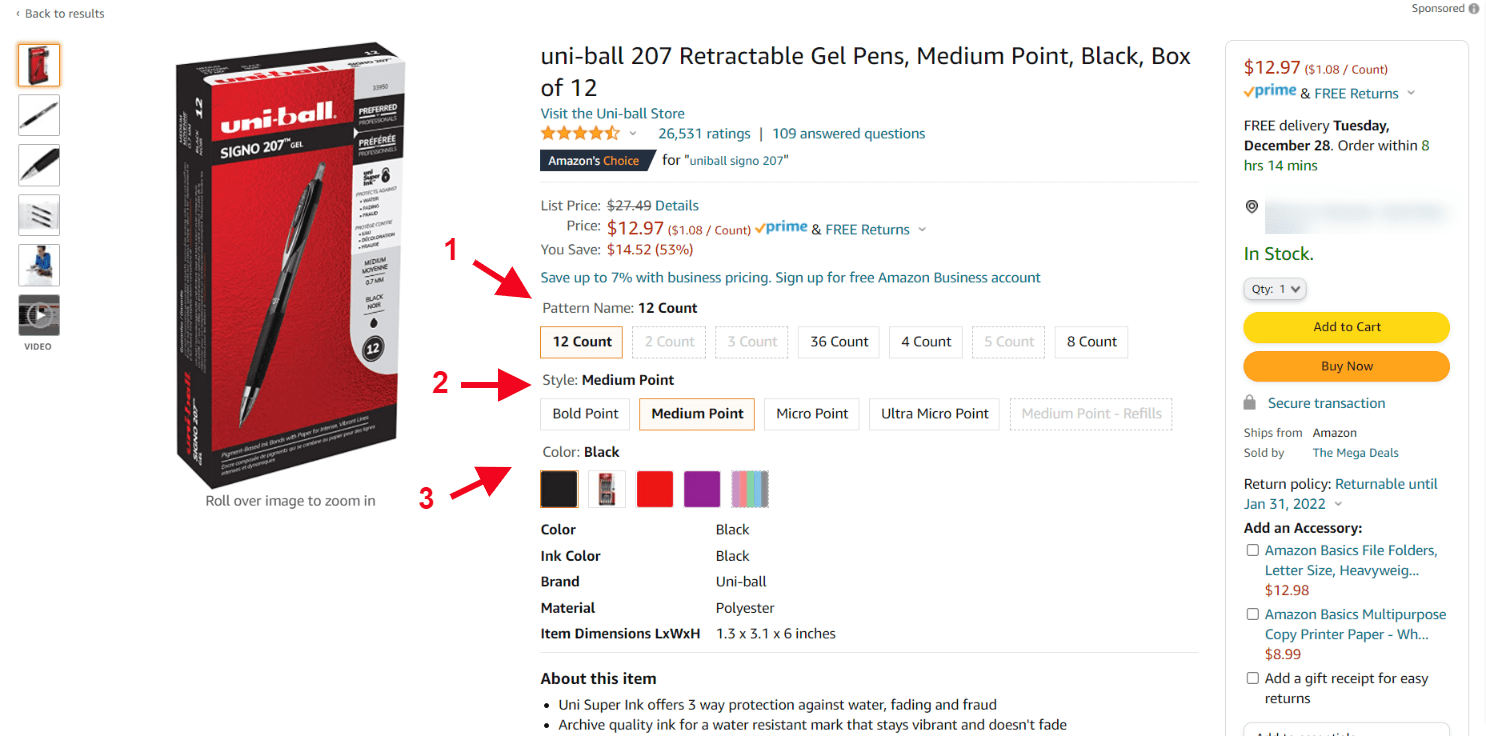How to Use Product Variations on Your Amazon Listing

As an Amazon seller, what do you do when you want to sell the same product in different sizes, colors, or flavors?
You create what’s called a parent-child relationship (i.e., variation). This allows you to offer customers multiple options under the same listing.
This not only makes the shopping experience convenient because shoppers don’t have to browse through multiple listings, but it also improves your product discoverability because you can focus on promoting one core listing instead of several.
In today’s article, we’re going to break down how to sell on Amazon using product variations and discuss the best practices for using them.
What is a Product Variation?
A product variation consists of a parent listing, which you can think of as a placeholder, and then the related products called child listings. Depending on the category of the product, each variation has a theme. An example of a variation theme might be size or flavor.
In some product categories, you can have two or more variation themes in one, for example, for a soda product you might choose six ounces as a size variation and Cherry Blossom as a flavor variation.
In the image below, you have two different size options and ten different color options.
If your product category doesn’t allow variations, you won’t see it as an available option in Seller Central. Additionally, some categories do not allow some variation themes. For perfumes, for example, you can create a color variation but not a scent variation.
Amazon says that a difference in fragrance would be considered a fundamental difference, and thus, it should go on an entirely separate listing.
Now keep in mind: You don’t want to overuse variations. Currently, you’re limited to 2000 child ASINs in a variation family, but that’s way more than you’d ever want to use. Here’s a list of some of the most common variation themes:
-
Size
-
Color
-
Flavor
-
Scent
-
Style
-
Weight
-
Quantity
For most categories, Amazon shows the top-selling variation as the default on the search results pages. However, if a customer searches for a specific variation, for example, “red cup,” then the red variation of your cup product may show up in the search results.
For the categories, clothing, accessories & luggage, sporting goods, and beauty, your parent listing—not the best-selling child ASIN—will show as the default on the search results page.
The Benefits of Product Variations
Increased Conversions
Shoppers may have different preferences for flavor, color, size, etc. When you have multiple options available on the same listing, you increase conversions because each shopper can satisfy their unique tastes.
Additionally, time spent engaging with a product, as well as, the customizability often increases conversions too. For example, when a customer gets to uniquely choose the style, size, and color variation, it increases their psychological investment toward buying your product.
Higher Visibility
When you combine listings through the parent-child relationship, the sales history between the variations are combined, which leads to a higher ranking in the search engine. This allows you to capitalize on a best-selling color, for example, and share the success across your product variations.
Increased Credibility
In the past, your child variations would all share the same reviews. This was a major advantage because it made selling product variations on Amazon a lot easier. It gave less favorable variations a boost in visibility.
Unfortunately, your variations no longer share the same reviews, but you still get a slight credibility boost by simply having your listings combined on the same page. Having separate reviews also helps improve the shopping experience for customers because a variation may have specific attributes that are more important to shoppers than other variations. For example, the red pen may smear when the black pen doesn’t.
The Best Practices of Product Variations
Amazon has suggestions for what you should avoid in product variations. They say they’ll remove products that don’t use variations appropriately.
Don’t combine entirely different products – for instance, a camera and a camera case.
Don’t include information outside of the product variation theme – The product variation should be related to the parent listing and variation theme. For example, you wouldn’t create a color variation labeled “blue Samsung phone case” on a parent listing of an Apple phone case.
Don’t bundle products via variation – You want to use Amazon’s new Virtual Bundles feature for creating product bundles.
Besides Amazon’s rules, there are other things you’ll want to consider when creating product variations:
-
Avoid wordy variation descriptors like the one you’ll see in the example below:
Notice that the color label says, “Heavy Duty Folders With 3 Holes 12 Packs.”
The seller would be better off making the label say “3 Holes” or “Heavy Duty Folders”—whichever best describes the product. They already have a second variation theme labeled “Size” that covers the size of the pack.
-
Avoid creating too many product variations. When you give too many options it can lead to what’s called the “paradox of choice.” You give so many options that it increases the shoppers’ doubt and uncertainty and leads to them not making any decision.
-
A good rule of thumb that Amazon suggests is that the product variations should be able to share the same title and description minus the product variation descriptor.
-
Accurately name your variations – This may seem self-explanatory, but it’s important to think about: When you offer variations on a listing, customers want the variation that they select.
On individual listings, this is less important because the consumer isn’t opting-in to a specific variation. For example, if you sell a product in sizes 3 oz, 4 oz, and 5 oz, make sure your 5 oz size is actually 5 oz, not 4.5 oz or 5.5 oz.
-
Label the variation by its most prominent feature – If you sell a round blue coffee mug and a square red coffee mug, it would be a better idea to label the variation theme “color” and have “blue” and “red” as the variations than it would be to have “round” and “square.”
-
Keep the variation labels consistent – For example, under a color variation theme for a cup product, don’t have a label that says “blue cup” and another says “round red cup”. If you’re going to focus on color, focus on the color and don’t include other descriptors like shape.
Wrapping Up
Depending on your product type, one of the simplest ways to boost sales is to add a product variation. The great thing about selling on Amazon is that there are all sorts of reliable tools that help you analyze the product variations that are most likely to sell.
If it makes sense for your Amazon FBA business, consider adding in a few variations on your listing. If you don’t, it’s only a matter of time before a competitor comes in and captures the customer segment you aren’t satisfying.
Happy Selling,
The Page.One Team
The Last Word:
With product variations, if you strategize appropriately, you can launch a product and have it shoot up the rankings in no time.
You must analyze the product variations that are selling the best and identify the descriptors that customers most resonate with.







